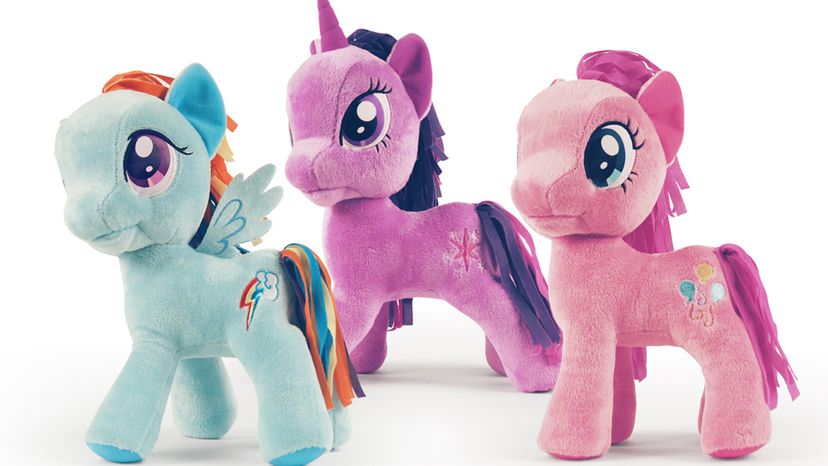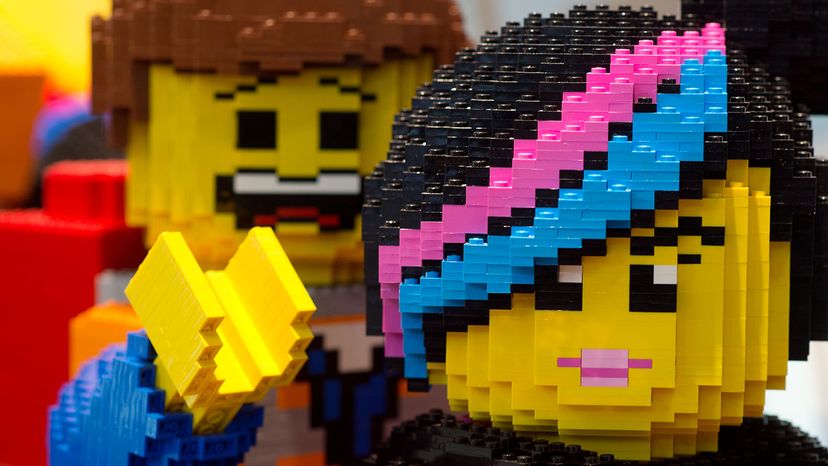
The earliest toys were deceptively simple and made from wood and other materials found around the house; popular toys from a century ago were designed purely for play. Even half a century ago, there was little thought of releasing toys based purely on whether or not they could support an animated series or motion picture. Today, toys are big business, and many end up spurring major franchises, inspiring TV shows, films and entire lines of non-toy merchandise. Read on to learn more about some toys that started small and went on to become big brands, eventually bringing in millions or even billions of dollars to their creative and manufacturing teams.
10: My Little Pony
Mattel produced the earliest versions of My Little Pony during the 1980s, enjoying modest sales until the franchise expanded into a full-fledged entertainment empire. MLP sales totaled a respectable $25 million in 1983; when the company released its first television special the next year, sales more than tripled to $85 million. By 1985, My Little Pony toys sold in excess of $100 million annually. A 1986 animated series helped the company sell more than150 million of the pastel-hued horses by the end of the '80s [source: Seiter]. The series enjoyed numerous revivals over the years, but interest truly peaked with the release of a 2010 animated series "My Little Pony: Friendship is Magic." People of all ages tuned in to relive their childhoods, or fell in love with MLP for the first time. In 2013, fans could choose from more than 200 licensed MLP products, and the Ponies themselves had become one of Hasbro's best-selling lines [sources: Global License and McGrath]. A theatrical release inspired by the series is scheduled for 2017.
Advertisement
9: Cabbage Patch Kids
Xavier Roberts was a 21-year old student when he came up with the idea for Cabbage Patch Kids. He started selling the dolls at local craft fairs as Little People in the late '70s, and later at Babyland General Hospital in Cleveland, Ga. The dolls were so popular they eventually attracted the attention of toy maker Coleco. Once Coleco began mass-production of the Cabbage Patch Kids, they became the hottest toy around, resulting in full-on fights at toy stores across the country come Christmas time. The company sold more than 3 million dolls in 1983 alone, and by 1985, annual sales exceeded $600 million [sources: Townsend, A. and Townsend]. While the demand for Cabbage Patch Kids eventually died down, the toy is still going strong more than three decades later, with sales of $50 million a year as of 2014 -- and yes, you can still take a visit to Babyland General Hospital to witness the miracle of CPK birth the next time you're in Georgia.
8: G.I. Joe
Hasbro launched the G.I. Joe toy line in 1964, and by 1966, the military-style dolls were responsible for two-thirds of the company's profits [source: Stamp]. As interest in G.I. Joe waned, Hasbro discontinued the line in the late '70s, only to re-introduce it again a few years later. This early-'80s Joe took on a whole new image, with a hard plastic body and a much smaller size -- similar to the design of the original "Star Wars" action figures which ruled toy stores at the time. This time, Hasbro launched a cartoon series to help promote the brand and spur sales. The tactic worked, and G.I. Joe toys have remained in continuous production for more than 30 years. A 2009 film inspired by the toy took in more than $300 million worldwide, while a 2013 sequel made a cool $375 million [source: O' Connell].

7: Care Bears
Believe it or not, the Care Bears started as a greeting card design, developed by American Greetings in the early '80s to sell cards and gifts. It wasn't until 1982 that someone decided the concept might work well as a toy, and a line of 10 plush bears was introduced to instant success. In just their first five years, the Care Bears line drew in more than $2 billion -- yes, billion -- in retail sales as kids clamored for the fuzzy, cheerful plush toys [source: American Greetings]. This impressive level of sales was no doubt helped by a 1985 animated feature film and animated series starring the Bears. More than 40 billion bears flew off store shelves by 1987, and the line is still going strong more than three decades after its introduction [source: Care-Bears.com].
6: Hot Wheels
Mattel launched the Hot Wheels line -- a series of miniature diecast metal cars -- in 1968. Despite a toy car market already dominated by the popular Matchbox line, Hot Wheels was an instant success. A 1969 animated series helped promote the brand, and the company sold more than 4 billion cars over the next 40 years [source: Hot Wheels Media]. The toys have reached such iconic status that some collections are valued in excess of $1 million. In 2013, Legendary Pictures tapped director Simon Crane to take the reins on a live-action movie inspired by Hot Wheels' rich history [source: Chitwood].
5: Teenage Mutant Ninja Turtles
When a pair of comic fans created the first Teenage Mutant Ninja Turtles comic in 1983, they had no idea they had created one of the most successful toy brands of all time. The comic sold quickly, and drew the attention of the Playmates toy company. Playmates created a simple 5-part cartoon mini-series featuring the pizza-loving turtles in 1987. When the series was a success, the company quickly launched a line of TMNT action figures. Over the next four years, Playmates sold more than a billion dollars worth of turtle toys to eager kids, and more than 400 different action figures were released over the next decade [source: Lammie]. The original mini-series was expanded into a full cartoon series, which stayed on the air through 1996. A 1990 live action film made $200 million in ticket sales, while a 2014 live-action TMNT film picked up almost $100 million its opening weekend, bringing the heroes in a half shell -- and their toys -- to a whole new generation of kids [source: Lang].

4: Lego
Ole Kirk Christiansen was a simple carpenter when he invested in a plastic injection kit during the 1940s. No one could have guessed that his company Lego would become one of the biggest toy makers on the planet in just over half a century. Despite a bump in the road during the '90s when the company faced down bankruptcy, Lego now holds rank with Mattel and Hasbro at the top of the toy industry chain. The company enjoyed $4.6 billion in toy sales in 2013, but the success didn't end there [source: Gustafsson]. A 2014 animated film grossed $69 million its opening weekend, and millions of families travel to half a dozen Lego theme parks each year to enjoy attractions inspired by the simple plastic building blocks [source: Feloni].
3: Monster High
Toys have always followed popular television shows and movies -- from the countless Mickey Mouse dolls on the market to the explosive sales of "Frozen" merchandise following the 2013 Disney blockbuster film. In 2010, Mattel flipped the toy merchandising concept on its head when it decided to develop a line of toys first, then come up with a TV series to help spur sales [source: Zimmerman]. Despite a lack of existing movies or series, Monster High dolls -- a cross between Bratz and classic movie monsters -- became the most in-demand toy for Christmas 2010. While the company took a huge risk investing in the toys before the brand was well known, the risk paid off in more than $500 million in annual sales by 2013 [source: Fox News]. A handful of television specials and online webisodes helped transform the "Monster High" name -- and toys -- into one of the biggest franchises in the toy industry just a few years after it was introduced.
2: Transformers
Transformers were a relatively unknown toy before Hasbro bought the rights to the robot line in 1984. When the company brought Transformers to the U.S., it also launched a line a comic books and an animated TV series to help promote the brand. The series was a smash hit, running through 1987, and helping to make these "robots in disguise" one of the most popular toys of the '80s. The franchise enjoyed a rebirth of sorts in 2007, with the release of a Michael Bay-directed feature film. That same year, sales of the Transformers toy line soared to $482 million due to the success of the film [source: Andrejczak] A series of sequels followed, all with its own line of merchandise. The fourth movie in the franchise, "Transformers: Age of Extinction," was the first film of 2014 to earn more than $1 billion at the global box office; not bad for a simpl, 30-year old toy [source: Lang].
1: Barbie
The Barbie doll came in just one design when she was first released in 1959 -- a "teenage fashion model" sporting a simple black and white bikini. Despite the doll's simplicity, she was smartly managed, with the Barbie name and image licensed to more than 100 companies by the 1960s [source: Rogers]. At just over 50 years after she was introduced, Barbie has grown to become one of the largest toy franchises in the world, with product licenses in more than 45 different categories of consumer products, from toys, clothes video games, branded stores and so much more [source: Barbie Media]. Despite stiff competition, Barbie remains the No. 1 doll brand in the world, with one sold every three seconds somewhere around the globe [source: Barbie Media]. By 2014, the Barbie brand was pulling in an impressive $3 billion a year, and the company was in talks with Sony to produce its first live-action theatrical release [source: Fleming].
Advertisement